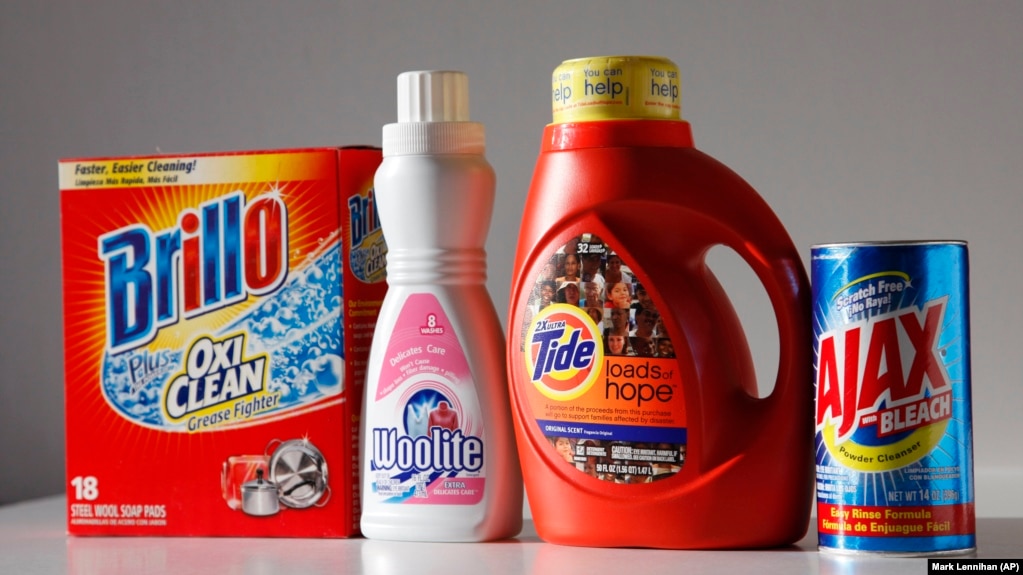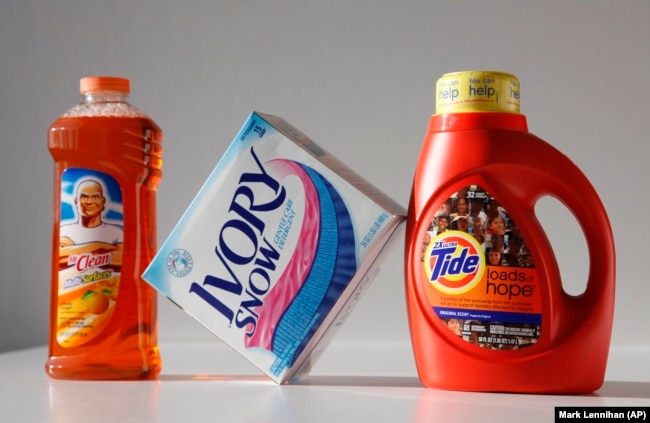
Cleaning products Brillo, Woolite, Tide and Ajax are arranged for a photo, Thursday, Feb. 4, 2010 in New York.
New parents who clean their homes very often to protect their babies from bacteria and other organisms might want to cut back their efforts.
A new study suggests that high levels of contact with cleaning products are linked to an increased risk of the childhood breathing condition known as asthma.
Researchers asked a group of parents how often they used 26 common household cleaners during their babies’ first three to four months of life. By age three, the children who had come in contact with cleaning products the most were more likely to be diagnosed with asthma. The researchers said that children who had a lot of contact with cleaners were 37 percent more likely to have asthma than children with the least contact.
The study also found that a lot of exposure to cleaning products caused children to be 35 percent more likely to have chronic difficulty breathing. In addition, they were 49 percent more likely to have chronic allergies.
Tim Takaro, who helped lead the study, is a doctor with Simon Fraser University in Vancouver, Canada. He told the Reuters news service he understands that parents want to make their homes safe for their children. But he suggests that they should question the belief that their home is clean only if it smells like chemical-based cleaning products.
“Instead, we propose that the smell of a healthy home is no smell at all,” said Takaro.
Takaro said parents should read labels and look for products that are free of substances like chemical colors and smells. Also, they should consider natural cleaning products instead of chemical ones.

Cleaning products are seen Thursday, Feb. 4, 2010 in New York.
The study appeared in the medical publication CMAJ earlier this month. The researchers wrote that the first months of life are very important for development of the body’s natural defenses, known as the immune system. The same is true for the organs involved in breathing.
Chemicals in cleaning products can cause chronic inflammation that may lead to asthma. It also may make symptoms appear more often and intensely, the researchers noted.
Asthma can be difficult to diagnose with breathing tests involving young children. So researchers also tested the children’s skin for allergies and asked parents how often children experienced symptoms like trouble breathing.
The most commonly used cleaning products in the study were dishwashing soap, multipurpose cleaners, glass cleaners and soap for washing clothes.
The American Lung Association recommends avoiding cleaning products that contain volatile organic substances and other irritants. But companies in Canada and the United States are not required to list all the chemicals in cleaning products. Some products labeled as environmentally friendly, or “green,” may contain harmful substances.
Elissa Abrams, who wrote comments on the study, is a doctor with the University of Manitoba in Winnipeg, Canada. She admitted that the effects of cleaning products are not well understood. But she believes these products and the chemicals they contain act as irritants to growing children.
Young children who spend a lot of time indoors may be at greater risk, said Abrams.
“The take-home message is that parents should be careful which cleaning products they use in the home,” she added.
I’m Pete Musto.
Lisa Rapaport reported this story for the Reuters news service. Pete Musto adapted it for VOA Learning English. Mario Ritter, Jr. was the editor. Write to us in the Comments Section or on our Facebook page.
Words in This Story
diagnose(d) – v. to recognize a disease or illness in someone
exposure – n. the fact or condition of being affected by something or experiencing something
chronic – adj. continuing or happening again and again for a long time
allergies – n. a kind of medical condition that causes someone to become sick after eating, touching, or breathing something that is harmless to most people
label(s) – n. a piece of paper, cloth, or similar material that is connected to something to identify or describe it
inflammation – n. a condition in which a part of your body becomes red, swollen, and painful
symptom(s) – n. a change in the body or mind which indicates that a disease is present
multipurpose – adj. having more than one use or purpose
volatile – adj. likely to become dangerous or out of control
irritant – n. something that makes part of your body sore and painful
Comprehension Quiz
What were the most commonly used cleaning products in the study?